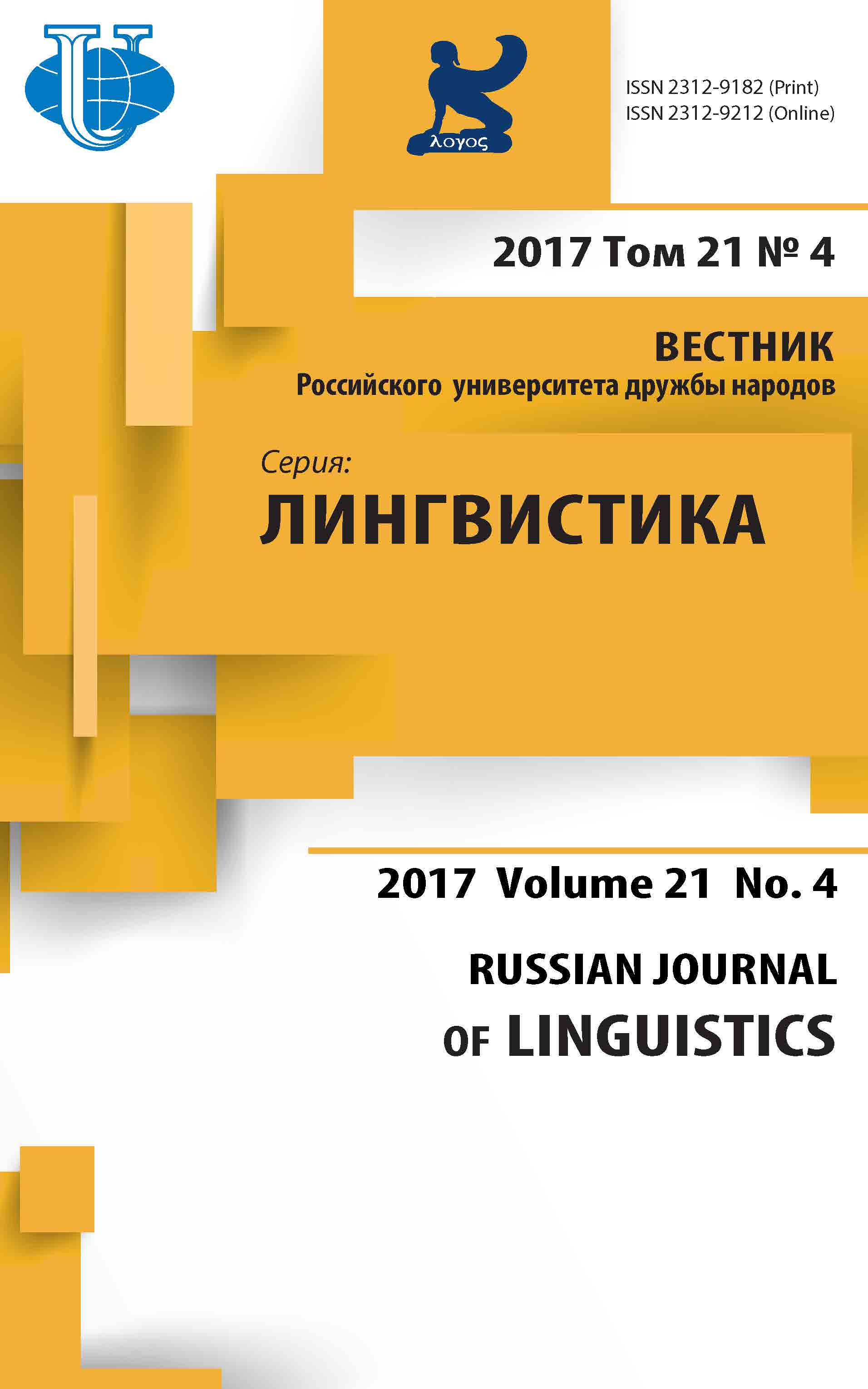RETHINKING THE TRANSLATOR’S ROLE WITHIN THE GILT PROJECT: AN INTEGRATED APPROACH
- Authors: Remkhe I.N1, Nefedova L.A1, Gillespie D.C2
-
Affiliations:
- Chelyabinsk State University
- University of Bath
- Issue: Vol 21, No 4 (2017)
- Pages: 910-926
- Section: Articles
- URL: https://journals.rudn.ru/linguistics/article/view/17317
- DOI: https://doi.org/10.22363/2312-9182-2017-21-4-910-926
- ID: 17317
Cite item
Full Text
Abstract
About the authors
Irina N Remkhe
Chelyabinsk State University
Email: rilix@mail.ru
Dr. Irina N. Remkhe, Associate Professor in the Department of Theory and Practice of Translation, Faculty of Linguistics and Translation, Chelyabinsk State University. Research interests: cognitive linguistics, intercultural communication, psycholinguistics, theory and practice of translation. Bratyev Kashirinykh Str., 129, Chelyabinsk, Russia, 454001
Liliya A Nefedova
Chelyabinsk State University
Email: lan2@mail.ru
Liliya A. Nefedova, Professor in the Department of Romance and Germanic Languages and Intercultural Communication, Faculty of Linguistics and Translation, Chelyabinsk State University. Research interests: general linguistics, theory of communication, intercultural communication, cognitive linguistics, theory and practice of translation. Bratyev Kashirinykh Str., 129, Chelyabinsk, Russia, 454001
David C Gillespie
University of Bath
Email: dcgillespie41@gmail.com
David C. Gillespie, Professor in the Department of Politics, Languages and International Studies, University of Bath. Research interests: Russian literature and film, Russian culture in the post-Soviet era. Claverton Down, Bath, North East Somerset BA2 7AY, United Kingdom
References
- Catford, J. C. (1965) A Linguistic Theory of Translation. An Essay in Applied Linguistics. London: Oxford University Press.
- Cuellar, S. B. (2008) Towards an Integrated Translation Approach. Proposal of a Dynamic Translation Model (DTM). Dissertation zur Erlangung des Grades des Doktors der Philosophie bei der Fakultät für Geisteswissenschaften Departements Sprach-, Literatur- und Medienwissenschaften I und II der Universität Hamburg.
- Dunne, K J. (2015) Localization: In: Routledge encyclopedia of translation technology / edited by Sin-Wai Chan. Routledge. P. 550-556.
- Esselink, B. (2000) A Practical Guide to Localisation, Amsterdam: Benjamins.
- Fedorov, A. V. (1953) Osnovy Obshchey Teorii Perevoda [Introduction into Translation]. Izdatel’stvo literatury na inostrannykh yazykakkh.
- Globalization and localization association. Available from: www.gala-global.org.
- Jakobson, R. (1959/2000). On Linguistic Aspects of Translation. In L. Venuti L (ed.). The Translation Studies Reader, New York. 2000 P. 113-118.
- Komissarov, V. N. (1973). Slovo o perevode [Towards the Issue of Translation]. М.: Mezhdunarodnye otnosheniya.
- Munday, J. (2008) Introducing Translation Studies: Theories and Applications. 2nd ed. London/ New York: Routledge, 2008.
- Neubert, A. (2000) Competence in Language, in Languages, and in Translation. In Developing Translation Competence, C. Schäffner and B. Adabs (eds.), 3-18. Amsterdam: John Benjamins.
- Newmark, P. (1981) Approaches to Translation, Oxford and New York: Pergamon.
- Nida, E. (1964) Toward a Science of Translating. Leiden: E. J. Brill.
- Olohan, M. (2016) Scientific and Technical Translation, London and New York: Routledge.
- PACTE (2003) Building a Translation Competence Model. In: ALVES, F. (ed.). Triangulating Translation: Perspectives in Process Oriented Research, Amsterdam: John Benjamins. Available from: http://www3.uji.es/~aferna/EA0921/3b-Translation-competence-model.pdf.
- Panou, D. (2013) Equivalence in Translation Theories: A Critical Evaluation. In: Theory and Practice in Language Studies. Vol. 3, No. 1, P. 1-6.
- Pym, A. (2004) The Moving Text: Localization, translation, and distribution / Benjamins Translation Library. Volume 49.
- Reiss, K. & Vermeer, H. J. (1984/1991) Grundlegung einer allgemeinen Translationstheorie. 2nd edition. Tübingen: Max Niemeyer Verlag.
- Remkhe I., Nefedova L., GillespieD. From function to system: advances in choosing a matrix structure of the translation process // Russian Journal of Linguistics. Vestnik RUDN, 2016, 20 (3), pp. 229-241.
- Retsker, Y. I. (1974) Teoriya Perevoda i Perevodcheskaya Praktika [The Theory of Translation and Translation Practice]. М.: Mezhdunarodniye otnosheniya.
- Shveitser, A. D. (1988) Teoriya Perevoda. Status, Problemy, Aspekty [Translation Theory. Status, Problems, Aspects]. Moscow: Nauka.
- Snell-Hornby, M. (1988) Translation Studies: An Integrated Approach - revised edition, Amsterdam/Philadelphia, John Benjamins Publishing Company, 1995. First Edition.
- Snell-Hornby, M. (2006) The Turns of Translation Studies: New Paradigms or Shifting Viewpoints? Benjamins Translation Library Vol. 66. Amsterdam/Philadelphia: John Benjamins, 2006.
- TILDE Neural MT. Available at: http://www.tilde.com/mt/neuralMT.
Supplementary files















